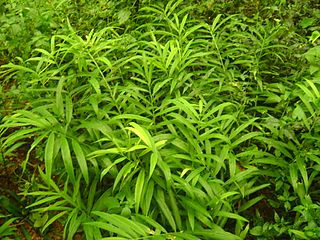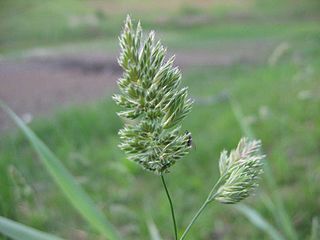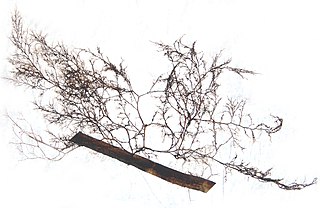
The Alismatales (alismatids) are an order of flowering plants including about 4,500 species. Plants assigned to this order are mostly tropical or aquatic. Some grow in fresh water, some in marine habitats. Perhaps the most important food crop in the order is the corm of the taro plant, Colocasia esculenta.

Flowering plants are plants that bear flowers and fruits, and form the clade Angiospermae, commonly called angiosperms. They include all forbs, grasses and grass-like plants, a vast majority of broad-leaved trees, shrubs and vines, and most aquatic plants. The term "angiosperm" is derived from the Greek words ἀγγεῖον / angeion and σπέρμα / sperma ('seed'), meaning that the seeds are enclosed within a fruit. They are by far the most diverse group of land plants with 64 orders, 416 families, approximately 13,000 known genera and 300,000 known species. Angiosperms were formerly called Magnoliophyta.

Arales is an order of flowering plants. The name was used in the Cronquist system for an order placed in subclass Arecidae, circumscribed as (1981):

The Araceae are a family of monocotyledonous flowering plants in which flowers are borne on a type of inflorescence called a spadix. The spadix is usually accompanied by, and sometimes partially enclosed in, a spathe. Also known as the arum family, members are often colloquially known as aroids. This family of 140 genera and about 4,075 known species is most diverse in the New World tropics, although also distributed in the Old World tropics and northern temperate regions.

Monocotyledons, commonly referred to as monocots, are grass and grass-like flowering plants (angiosperms), the seeds of which typically contain only one embryonic leaf, or cotyledon. They constitute one of the major groups into which the flowering plants have traditionally been divided; the rest of the flowering plants have two cotyledons and are classified as dicotyledons, or dicots.

Acorus calamus is a species of flowering plant with psychoactive chemicals. It is a tall wetland monocot of the family Acoraceae, in the genus Acorus. Although used in traditional medicine over centuries to treat digestive disorders and pain, there is no clinical evidence for its safety or efficacy – and ingested calamus may be toxic – leading to its commercial ban in the United States.

Juncaceae is a family of flowering plants, commonly known as the rush family. It consists of 8 genera and about 464 known species of slow-growing, rhizomatous, herbaceous monocotyledonous plants that may superficially resemble grasses and sedges. They often grow on infertile soils in a wide range of moisture conditions. The best-known and largest genus is Juncus. Most of the Juncus species grow exclusively in wetland habitats. A few rushes, such as Juncus bufonius are annuals, but most are perennials.

Juncaginaceae is a family of flowering plants, recognized by most taxonomists for the past few decades. It is also known as the arrowgrass family. It includes 3 genera with a total of 34 known species.

In plant taxonomy, commelinids is a clade of flowering plants within the monocots, distinguished by having cell walls containing ferulic acid.

Najadales is the botanical name of an order of flowering plants. A well-known system that used this name is the Cronquist system (1981), which used this name for an order in subclass Alismatidae with this circumscription:

Tofieldiaceae is a family of flowering plants in the monocot order Alismatales. The family is divided into four genera, which together comprise 28 known species. They are small, herbaceous plants, mostly of arctic and subarctic regions, but a few extend further south, and one genus is endemic to northern South America and Florida. Tofieldia pusilla is sometimes grown as an ornamental.

Acorus americanus, the American sweet flag, is an emergent wetland plant native to the northern United States and Canada. This perennial plant has bright green blade-shaped leaves that arise directly from the rhizomes and sheath into each other at the base. Additionally the blades have 2-6 raised veins, and a swollen center when viewed in cross section. The foliage has a citrus-like spicy aromatic quality, and can be used to flavor beer. It is a flowering plant with inconspicuous flowers that are arranged on a lateral spadix and the fertilized flowers produce berries with a jelly inside. This plant is protected as a state endangered species in Pennsylvania.

Asarone is chemical compound of the phenylpropanoid class found in certain plants such as Acorus and Asarum. There are two isomers, α and β. As a volatile fragrance oil, it is used in killing pests and bacteria.

Butomus is the only known genus in the plant family Butomaceae, native to Europe and Asia. It is considered invasive in some parts of the United States.

The basal angiosperms are the flowering plants which diverged from the lineage leading to most flowering plants. In particular, the most basal angiosperms were called the ANITA grade, which is made up of Amborella, Nymphaeales and Austrobaileyales.

Arisarum is a genus of flowering plants in the family Araceae. It is native to the Mediterranean region, east to the Caucasus and west to Macaronesia.

Mesangiospermae is a clade of flowering plants (angiosperms), informally called "mesangiosperms". They are one of two main groups of angiosperms. It is a name created under the rules of the PhyloCode system of phylogenetic nomenclature. There are about 350,000 species of mesangiosperms. The mesangiosperms contain about 99.95% of the flowering plants, assuming that there are about 175 species not in this group and about 350,000 that are. While such a clade with a similar circumscription exists in the APG III system, it was not given a name.

Lilioid monocots is an informal name used for a grade of five monocot orders in which the majority of species have flowers with relatively large, coloured tepals. This characteristic is similar to that found in lilies ("lily-like"). Petaloid monocots refers to the flowers having tepals which all resemble petals (petaloid). The taxonomic terms Lilianae or Liliiflorae have also been applied to this assemblage at various times. From the early nineteenth century many of the species in this group of plants were put into a very broadly defined family, Liliaceae sensu lato or s.l.. These classification systems are still found in many books and other sources. Within the monocots the Liliaceae s.l. were distinguished from the Glumaceae.

Alismatid monocots is an informal name for a group of early branching monocots, consisting of two orders, the Acorales and Alismatales. The name has also been used to refer to the Alismatales alone. Monocots are frequently treated as three informal groupings based on their branching from ancestral monocots and shared characteristics: alismatid monocots, lilioid monocots and commelinid monocots. Research at the Royal Botanical Gardens, Kew is organised into two teams I: Alismatids and Lilioids and II: Commelinids. A similar approach is taken by Judd in his Plant systematics.





















